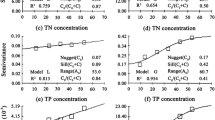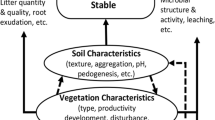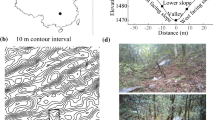Abstract
Purpose
Soil properties are highly heterogeneous in forest ecosystems, which poses difficulties in estimating soil carbon (C) and nitrogen (N) pools. However, little is known about the relative contributions of environmental factors and vegetation to spatial variations in soil C and N, especially in highly diverse mixed forests. Here, we examined the spatial variations of soil organic carbon (SOC) and total nitrogen (TN) in a subtropical mixed forest in central China, and then quantified the main drivers.
Materials and methods
Soil samples (n = 972) were collected from a 25-ha forest dynamic plot in Badagonshan Nature Reserve, central China. All trees with diameter at breast height (DBH) ≥1 cm and topography data in the plot were surveyed in detail. Geostatistical analyses were used to characterize the spatial variability of SOC and TN, while variation partitioning combined with Mantel’s test were used to quantify the relative contribution of each type of factors.
Results and discussion
Both surface soil (0–10 cm) and subsurface soil (10–30 cm) exhibited moderate spatial autocorrelation with explainable fractions ranged from 31 to 47 %. The highest contribution to SOC and TN variation came from soil variables (including soil pH and available phosphorus), followed by vegetation and topographic variables. Although the effect of topography was weak, Mantel’s test still showed a significant relationship between topography and SOC. Strong interactions among these variables were discovered. Compared with surface soil, the explanatory power of environmental variables was much lower for subsurface soil.
Conclusions
The differences in relative contributions between surface and subsurface soils suggest that the dominating ecological process are likely different in the two soil depths. The large unexplained variation emphasized the importance of fine-scale variations and ecological processes. The large variations in soil C and N and their controlling mechanisms should be taken into account when evaluating how forest managements may affect C and N cycles.




Similar content being viewed by others
References
Adu-Bredu S, Yokota T, Ogawa K, Hagihara A (1997) Tree size dependence of litter production, and above-ground net production in a young hinoki (Chamaecyparis obtusa) stand. J Forest Res 2:31–37
Blanchet FG, Legendre P, Borcard D (2008) Forward selection of explanatory variables. Ecology 89:2623–2632
Borcard D, Legendre P (2002) All-scale spatial analysis of ecological data by means of principal coordinates of neighbour matrices. Ecol Model 153:51–68
Borcard D, Legendre P, Drapeau P (1992) Partialling out the spatial component of ecological variation. Ecology 73:1045–1055
Bradford JB, Birdsey RA, Joyce LA, Ryan MG (2008) Tree age, disturbance history, and carbon stocks and fluxes in subalpine Rocky Mountain forests. Glob Chang Biol 14:2882–2897
Chen HYH, Shrestha BM (2012) Stand age, fire and clearcutting affect soil organic carbon and aggregation of mineral soils in boreal forests. Soil Biol Biochem 50:149–157
Chung H, Zak DR, Reich PB, Ellsworth DS (2007) Plant species richness, elevated CO2, and atmospheric nitrogen deposition alter soil microbial community composition and function. Glob Chang Biol 13:980–989
Cleveland CC, Reed SC, Townsend AR (2006) Nutrient regulation of organic matter decomposition in a tropical rain forest. Ecology 87:492–503
Condit R (1998) Tropical forest census plots: methods and results from Barro Colorado Island, Panama and a comparison with other plots. Springer, Heidelberg
Cong WF, van Ruijven J, Mommer L, De Deyn GB, Berendse F, Hoffland E (2014) Plant species richness promotes soil carbon and nitrogen stocks in grasslands without legumes. J Ecol 102:1163–1170
Curtin D, Campbell CA, Jalil A (1998) Effects of acidity on mineralization: pH-dependence of organic matter mineralization in weakly acidic soils. Soil Biol Biochem 30:57–64
Davidson EA, Janssens IA (2006) Temperature sensitivity of soil carbon decomposition and feedbacks to climate change. Nature 440:165–173
De Deyn GB, Cornelissen JHC, Bardgett RD (2008) Plant functional traits and soil carbon sequestration in contrasting biomes. Ecol Lett 11:516–531
Díaz S, Cabido M (2001) Vive la difference: plant functional diversity matters to ecosystem processes. Trends Ecol Evol 16:646–655
Díaz-Pinés E, Rubio A, van Miegroet H, Benito M, Montes F (2011) Does tree species composition control soil organic carbon pools in Mediterranean mountain forests? For Ecol Manag 262:1895–1904
Ding J, Wu Q, Yan H, Zhang SR (2011) Effects of topographic variations and soil characteristics on plant functional traits in a subtropical evergreen broad-leaved forest. Biodivers Sci 19:158–167 (in Chinese)
Dray S (2011) Pack for: Forward Selected with Multivariate Y by Permutation Under Reduced Model. Laboratoire Biométrie et Biologie Évolutive, Lyon
Ettema CH, Wardle DA (2002) Spatial soil ecology. Trends Ecol Evol 17:177–183
Fornara DA, Tilman D (2008) Plant functional composition influences rates of soil carbon and nitrogen accumulation. J Ecol 96:314–322
Gallardo A (2003) Spatial variability of soil properties in a floodplain forest in northwest Spain. Ecosys 6:564–576
Gallardo A, Paramá R (2007) Spatial variability of soil elements in two plant communities of NW Spain. Geoderma 139:199–208
Goovaerts P (1998) Geostatistical tools for characterizing the spatial variability of microbiological and physico-chemical soil properties. Biol Fert Soils 27:315–334
Guo YL, Lu JM, Franklin SB, Wang QG, Xu YZ, Zhang KH, Bao DC, Qiao XJ, Huang HD, Lu ZJ, Jiang MX (2013) Spatial distribution of tree species in a species-rich subtropical mountain forest in central China. Can J For Res 43:826–835
Hicks RR, Frank PS (1984) Relationship of aspect to soil nutrients, species importance and biomass in a forested watershed in West Virginia. For Ecol Manag 8:281–291
Hobbie SE, Vitousek PM (2000) Nutrient limitation of decomposition in Hawaiian forests. Ecology 81:1867–1877
Hook PB, Burke IC (2000) Biogeochemistry in a shortgrass landscape: control by topography, soil texture, and microclimate. Ecology 81:2686–2703
Huang ZQ, Wan XH, He ZM, Yu ZP, Wang MH, Hu ZH, Yang YS (2013) Soil microbial biomass, community composition and soil nitrogen cycling in relation to tree species in humid subtropical China. Soil Biol Biochem 62:68–75
Huang ZQ, Yu ZP, Wang MH (2014) Environmental controls and the influence of tree species on temporal variation in soil respiration in subtropical China. Plant Soil 382:75–87
Jobbágy EG, Jackson RB (2000) The vertical distribution of soil organic carbon and its relation to climate and vegetation. Ecol Appl 10:423–436
Kaspari M, Garcia MN, Harms KE, Santana M, Wright SJ, Yavitt JB (2008) Multiple nutrients limit litterfall and decomposition in a tropical forest. Ecol Lett 11:35–43
Kleb HR, Wilson SD (1997) Vegetation effects on soil resource heterogeneity in prairie and forest. Am Natural 150:283–298
Legendre P, Dale MRT, Fortin M-J, Gurevitch J, Hohn M, Myers D (2002) The consequences of spatial structure for the design and analysis of ecological field surveys. Ecography 25:601–615
Liski J (1995) Variation in soil organic carbon and thickness of soil horizons within a boreal forest stand-effect of trees and implications for sampling. Silva Fenn 29:255–266
Liu BX (1983) The soil in the Badagongshan National Nature Reserve. J Central South For Inst 3:141–158 (in Chinese)
Mills RTE, Tipping E, Bryant CL, Emmett BA (2014) Long-term organic carbon turnover rates in natural and semi-natural topsoils. Biogeochemistry 118:257–272
Mueller KE, Hobbie SE, Oleksyn J, Reich PB, Eissenstat DM (2012) Do evergreen and deciduous trees have different effects on net N mineralization in soil? Ecology 93:1463–1472
Muukkonen P, Häkkinen M, Mäkipää R (2009) Spatial variation in soil carbon in the organic layer of managed boreal forest soil—implications for sampling design. Environ Monit Assess 158:67–76
O’Rourke SM, Angers DA, Holden NM, McBratney AB (2015) Soil organic carbon across scales. Glob Chang Biol 21:3561–3574
Oksanen J, Blanchet FG, Kindt R, Legendre P, O’Hara RB, Simpson GL, Solymos P, Stevens MHH, Wagner H (2016) Vegan: community ecology package, version 2.3–5. URL http://CRAN.R-project.org
Ortiz CA, Liski J, Gärdenäs AI, Lehtonen A, Lundblad M, Stendahl J, Ågren GI, Karltun E (2013) Soil organic carbon stock changes in Swedish forest soils—a comparison of uncertainties and their sources through a national inventory and two simulation models. Ecol Model 251:221–231
Peri PL, Ladd B, Pepper DA, Bonser SP, Laffan SW, Amelung W (2012) Carbon (δ13C) and nitrogen (δ15N) stable isotope composition in plant and soil in southern Patagonia’s native forests. Glob Chang Biol 18:311–332
Pregitzer KS, Euskirchen ES (2004) Carbon cycling and storage in world forests: biome patterns related to forest age. Glob Chang Biol 10:2052–2077
Qiao XJ, Li QX, Jiang QH, Lu JM, Franklin S, Tang ZY, Wang QG, Zhang JX, Lu ZJ, Bao DC, Guo YL, Liu HB, Xu YZ, Jiang MX (2015) Beta diversity determinants in Badagongshan, a subtropical forest in central China. Sci Rep 5:17043
R Development Core Team (2016) R: A language and environment for statistical computing. Vienna, Austria. URL http://www.R-project.org
Rousk J, Brookes PC, Bååth E (2009) Contrasting soil pH effects on fungal and bacterial growth suggest functional redundancy in carbon mineralization. Appl Environ Microbiol 75:1589–1596
Rumpel C, Kögel-Knabner I (2011) Deep soil organic matter—a key but poorly understood component of terrestrial C cycle. Plant Soil 338:143–158
Ryżak M, Bieganowski A (2011) Methodological aspects of determining soil particle-size distribution using the laser diffraction method. J Plant Nutr Soil Sci 174:624–633
Seibert J, Stendahl J, Sørensen R (2007) Topographical influences on soil properties in boreal forests. Geoderma 141:139–148
Silver WL, Neff J, McGroddy M, Veldkamp E, Keller M, Cosme R (2000) Effects of soil texture on belowground carbon and nutrient storage in a lowland Amazonian forest ecosystem. Ecosys 3:193–209
Soil Survey Staff (1999) Soil taxonomy: A basic system of soil classification for making and interpreting soil surveys. 2nd edition. Natural Resources Conservation Service. U.S. Department of Agriculture Handbook 436. Washington DC, USA
Stockmann U, Adams MA, Crawford JW, Field DJ, Henakaarchchi N, Jenkins M, Minasny B, McBratney AB, de Courcelles V, Singh K, Wheeler I, Abbott L, Angers DA, Baldock J, Bird M, Brookes PC, Chenu C, Jastrow JD, Lal R, Lehmann J, O’Donnell AG, Parton WJ, Whitehead D, Zimmermann M (2013) The knowns, known unknowns and unknowns of sequestration of soil organic carbon. Agric Ecosyst Environ 164:80–99
Townsend AR, Asner GP, Cleveland CC (2008) The biogeochemical heterogeneity of tropical forests. Trends Ecol Evol 23:424–431
Tsui CC, Chen ZS, Hsieh CF (2004) Relationships between soil properties and slope position in a lowland rain forest of southern Taiwan. Geoderma 123:131–142
Vogel C, Mueller CW, Höschen C, Buegger F, Heister K, Schulz S, Schloter M, Kögel-Knabner I (2014) Submicron structures provide preferential spots for carbon and nitrogen sequestration in soils. Nat Commun 5:149–168
Von Lützow M, Kögel-Knabner I (2009) Temperature sensitivity of soil organic matter decomposition—what do we know? Biol Fertil Soils 46:1–15
Wiesmeier M, Hübner R, Barthold F, Spörleind P, Geußd U, Hangend E, Reischld A, Schillingd B, Von Lützowa M, Kögel-Knabner I (2013) Amount, distribution and driving factors of soil organic carbon and nitrogen in cropland and grassland soils of southeast Germany (Bavaria). Agric Ecosyst Environ 176:39–52
Xu ZH, Ward S, Chen CR, Blumfield T, Prasolova NV, Liu JX (2008) Soil carbon and nutrient pools, microbial properties and gross nitrogen transformations in adjacent natural forest and hoop pine plantations of subtropical Australia. J Soils Sediments 8:99–105
Yuan ZQ, Li BH, Bai XJ, Lin F, Shi S, Ye J, Wang XG, Hao ZQ (2010) Composition and seasonal dynamics of litter falls in a broad-leaved Korean pine mixed forest in Changbai Mountains, Northeast China. Chin J Appl Ecol 21:2171–2178 (in Chinese)
Yuan ZQ, Gazol A, Lin F, Ye J, Shi S, Wang XG, Wang M, Hao ZQ (2013) Soil organic carbon in an old-growth temperate forest: spatial pattern, determinants and bias in its quantification. Geoderma 195:48–55
Zhang LW, Mi XC, Shao HB, Ma KP (2011) Strong plant-soil associations in a heterogeneous subtropical broad-leaved forest. Plant Soil 347:211–220
Acknowledgments
This study was funded by the National Basic Research Program of China (grant no. 2014CB954004) and the National Natural Science Foundation (grant nos. 31270515 and 31400463). We thank the Badagongshan National Nature Reserve for field assistance and support. We are grateful for constructive comments and suggestions from anonymous reviewers and the Editor.
Author information
Authors and Affiliations
Corresponding author
Additional information
Responsible editor: Zhiqun Huang
Rights and permissions
About this article
Cite this article
Li, Q., Wang, X., Jiang, M. et al. How environmental and vegetation factors affect spatial patterns of soil carbon and nitrogen in a subtropical mixed forest in Central China. J Soils Sediments 17, 2296–2304 (2017). https://doi.org/10.1007/s11368-016-1491-5
Received:
Accepted:
Published:
Issue Date:
DOI: https://doi.org/10.1007/s11368-016-1491-5




